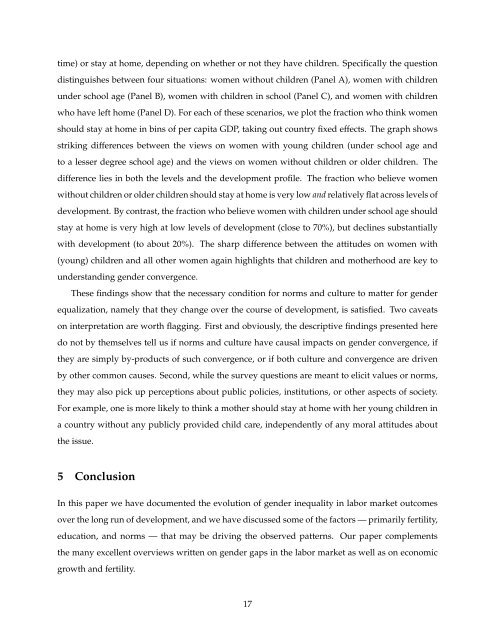Gender Inequality and Economic Development Fertility Education and Norms
kleven-landais_economica_jan2017
kleven-landais_economica_jan2017
You also want an ePaper? Increase the reach of your titles
YUMPU automatically turns print PDFs into web optimized ePapers that Google loves.
time) or stay at home, depending on whether or not they have children. Specifically the question<br />
distinguishes between four situations: women without children (Panel A), women with children<br />
under school age (Panel B), women with children in school (Panel C), <strong>and</strong> women with children<br />
who have left home (Panel D). For each of these scenarios, we plot the fraction who think women<br />
should stay at home in bins of per capita GDP, taking out country fixed effects. The graph shows<br />
striking differences between the views on women with young children (under school age <strong>and</strong><br />
to a lesser degree school age) <strong>and</strong> the views on women without children or older children. The<br />
difference lies in both the levels <strong>and</strong> the development profile. The fraction who believe women<br />
without children or older children should stay at home is very low <strong>and</strong> relatively flat across levels of<br />
development. By contrast, the fraction who believe women with children under school age should<br />
stay at home is very high at low levels of development (close to 70%), but declines substantially<br />
with development (to about 20%). The sharp difference between the attitudes on women with<br />
(young) children <strong>and</strong> all other women again highlights that children <strong>and</strong> motherhood are key to<br />
underst<strong>and</strong>ing gender convergence.<br />
These findings show that the necessary condition for norms <strong>and</strong> culture to matter for gender<br />
equalization, namely that they change over the course of development, is satisfied. Two caveats<br />
on interpretation are worth flagging. First <strong>and</strong> obviously, the descriptive findings presented here<br />
do not by themselves tell us if norms <strong>and</strong> culture have causal impacts on gender convergence, if<br />
they are simply by-products of such convergence, or if both culture <strong>and</strong> convergence are driven<br />
by other common causes. Second, while the survey questions are meant to elicit values or norms,<br />
they may also pick up perceptions about public policies, institutions, or other aspects of society.<br />
For example, one is more likely to think a mother should stay at home with her young children in<br />
a country without any publicly provided child care, independently of any moral attitudes about<br />
the issue.<br />
5 Conclusion<br />
In this paper we have documented the evolution of gender inequality in labor market outcomes<br />
over the long run of development, <strong>and</strong> we have discussed some of the factors — primarily fertility,<br />
education, <strong>and</strong> norms — that may be driving the observed patterns. Our paper complements<br />
the many excellent overviews written on gender gaps in the labor market as well as on economic<br />
growth <strong>and</strong> fertility.<br />
17


